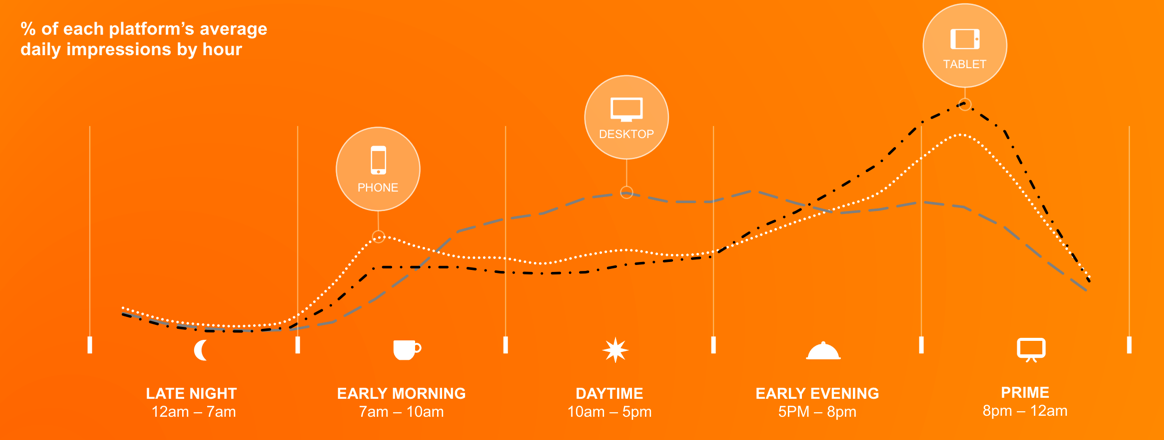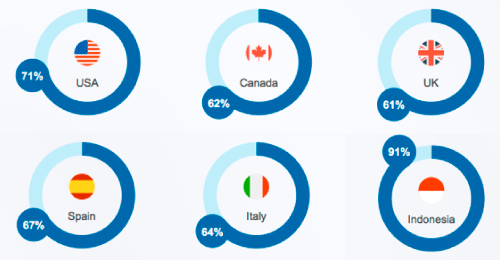You have set your goals and objectives. Now to decide which elements of your marketing strategy are essential and need to be at the top of the list. These are two components you should target.
1. Comprehensive Mobile Capability
Retail industries rely more heavily on mobile than others, but every brand must have solid mobile capabilities if they want to attract and retain customers.
According to Smart Insights, mobile usage makes up 71% of all digital minutes in the U.S., and outweighs PC usage in other countries.
Across the globe, mobile devices dominate total minutes spent online, passing 91% in Indonesia.
% mobile share of total digital minutes
Source: Smart Insights
And mobile usage outweighs PC usage in three out of four day-parts, most importantly the “prime” day-part, defined as 8pm-12am.

Source: Smart Insights
So you can see that if you’re not working a strong mobile strategy, you could be missing out on a whole lot of potential customers.
What do you need in your mobile strategy? Today, you have to do more than just optimize your website for mobile visitors. You’ve also got to employ mobile-friendly ads, possibly offer a mobile app, and most importantly, create a seamless customer experience no matter what device those customers are on, whatever their location in the customer journey.
Remember, your mobile strategy is not simply an extension of your overall digital strategy. It needs to have something unique, some element that caters specifically to mobile visitors. Think about the company apps you like the best. They’re not just a mobile version of the company website – that would be pretty boring, right?
2. Email Marketing
Yes, the powers that be have lamented the imminent death of email marketing many times now. But every time it turns out to be a false alarm.
Email marketing is still alive and well, not to mention necessary. It’s actually one of the most effective ways to drive traffic to your site, with incredibly high ROI. According to 2015 research, for every $1 spent, the average return is $44.25.
So how do you create an amazing email marketing strategy, one that earns you more customers rather than turning them off of your brand?
Here are a few pointers.
Email regularly, but not more than 3 times per week and not less than 1 time per month.
Generally, twice a week is about right. However, some customers may actually want 3 emails a week, especially if your industry is a fast-moving one where knowing something first gives them an edge. That could be anything from when your exclusive clothing line is going on sale, or when they can get on a waiting list for a limited-edition spice blend.
Segment your audience.
Just like ultra-targeting with paid social ads, segmenting your email list allows you to better target people based on interest and activity.
For example, let’s take the above rule of emailing no more than 3 times per week. While your baseline might be sending 2 emails per week, there may be some customers – more frequent buyers, or people who click through your emails more frequently than others – who would be good candidates for 3 emails a week.
Those who shop less frequently may only want 2 emails a month, or even 1.
By segmenting this way, you lower the risk of losing customers because they think you’re emailing them too much.
Pay special attention to your subject line.
You’ve surely heard this one before, but it’s so important that it bears repeating. Your subject line is vital – a great one can mean that your open rate goes way up, while a so-so one can mean your open rate plummets.
A great subject line is one that’s specific, honest, and short – in fact, as we’ve written about before, research shows that subject lines fewer than 10 characters long have an open rate of 58%, while personalized subject lines are 22.2% more likely to be opened.
Excerpts by Shama Hyder, The Marketing Zen Group, www.marketingzen.com
Header image courtesy: freepik.com


